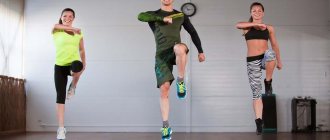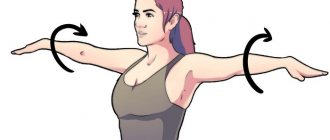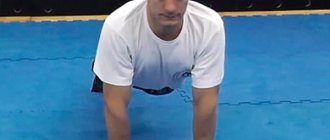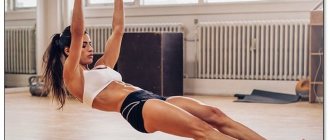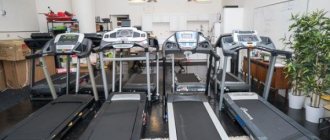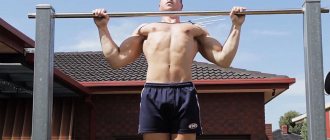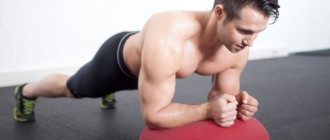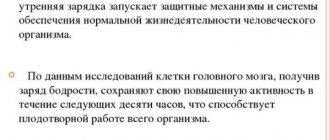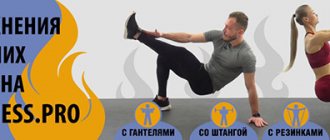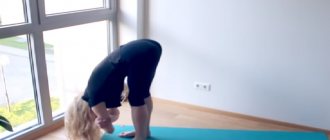It is known that some tricks cannot be performed without sophisticated equipment and pre-prepared props. However, what makes a person a magician is not the mastery of all these devices, but the sleight of hand, which allows one to create real miracles with the help of seemingly ordinary objects. Card tricks, tricks with coins, manipulations with scarves, flowers, the disappearance and appearance of things taken from spectators - this is just a short list of what you can do after learning to use your hands.
It was tricks involving the manipulation of objects that brought fame to many famous illusionists. However, street magicians also use this skill. For example, the famous game of “thimble,” which is almost impossible for a beginner to win, is built precisely on distraction and sleight of hand.
What does the concept of agility include?
Agility should be understood as the ability to quickly change the position of the body in space while maintaining balance. Athletes who focus on increasing muscle strength and power experience considerable difficulty in developing this skill.
Regularly performing exercises to develop dexterity allows you to hone movements to perfection, which are accompanied by the difficulty of coordinating the body in space. This moment requires the use of a wide range of muscles simultaneously and the immediate activation of reflexes.
One of the criteria of dexterity is the accuracy of movements. Without bringing the parameter to perfection, there is an inevitable loss of balance. Progress can be achieved here by training the vestibular apparatus and developing the necessary reactions from the nervous system.
An important point in achieving agility is the speed of spatial change in body position. The faster a person groups his limbs dynamically, the greater the effect of the expended strength and power.
Agility in sports and fitness
Agility is a complex motor quality. It integrates precision and speed of movement, reaction speed, sense of balance, flexibility, and coordination. Moreover, it is not so important to learn to achieve the maximum values of these qualities as to be able to demonstrate them in doses. In other words, to successfully solve a motor task, you need to be able to develop a movement of the required amplitude, direction and strength at each specific moment in time. It is important to learn to accurately coordinate your movements, quickly and in a timely manner to move from one movement to another. These abilities are based on the well-functioning functioning of the nervous system and muscles.
Although agility is considered an innate quality, this does not mean that it cannot be trained. When a person develops reaction speed or coordination of movements, he thereby improves dexterity. Dexterity directly depends on experience. The more varied speed and reaction exercises a person performs, the richer his motor experience becomes, and the more accurately he can predict the development of events. His reaction to external stimuli becomes very fast. A dexterous person is able to react with lightning speed to a change in the situation - sometimes even before this change has occurred.
Agility is an important quality for people interested in sports and fitness. To achieve success in boxing, gymnastics, martial arts and team sports, you need to purposefully develop your agility. But, on the other hand, all of the listed sports disciplines and many other types of sports and fitness in themselves perfectly develop coordination, accuracy and speed of movements. Let's look at the main types of physical exercises that are used to develop dexterity.
What sports provide agility development?
There is a wide range of sports disciplines that help improve agility performance:
- cross-country skiing, biathlon, snowboarding;
- figure skating;
- skating;
- trampolining;
- synchronized swimming, diving;
- freestyle cycling and motorcycle racing;
- Athletics;
- team games.
The development of agility is also achieved through all-around training. Skill progress is observed while performing any exercises on the bar. Various types of long and high jumps can only be successfully performed by athletes who know how to change the position of the body in space in a limited time period.
Who needs to develop coordination of movements?
Apart from athletes, absolutely everyone needs this skill or ability, because the implementation of all human movements depends on it. As stated at the beginning of the article, motor coordination is an important skill that should be sufficiently developed in everyone, but some people need an excellent level of this motor function. For example, dancers without developed coordination simply have no chance. For athletes of any kind of martial arts, athletics, all team sports, even in motorsports, coordination plays an important role. By the way, the work of the vestibular apparatus is also one of the components of coordination. Sailing is a craft in which coordination is sometimes at the forefront of human ability.
Jumping rope
Let's move on to talking about exercises to develop dexterity, flexibility and coordination. One of the best solutions to achieve your goal is jumping rope. First, take a vertical stance, placing your feet together. They hop on the right and left legs, alternating limbs. After completing a series of exercises, they begin to cross the rope with their hands in front of them after one revolution.
Training promotes the development of coordination in the hand-foot-eye system. Improves sense of time and level of endurance. The rhythm of movements is honed.
What is agility
The origin of the word “dexterity” goes back to the word “lov” - “to catch”. Previously, the ability of a fisherman or hunter to obtain a sufficient amount of food depended on this skill.
As a rule, agility refers to a combination of different qualities: flexibility, speed of reaction, mobility, coordination and accuracy of movements.
If these qualities are sufficiently developed, the body acquires a special tone, not allowing various surprises to take itself by surprise.
A tourist, jumping over bushes near a deep stream that was not noticed in time, will be able to react effectively and correctly already in flight.
Balancing in a one-legged stance
A set of exercises to develop dexterity should include balancing on your leg. The essence of the training is as follows. Take a straight stance with your arms spread wide to the sides. The support is performed on one leg. The second limb is slightly bent at the knee, holding it suspended. In this position, the head is tilted to the right and left, back and forth. They try not to concentrate their gaze on the surrounding objects, which makes it easier to maintain balance. When the exercise for developing dexterity begins to be easy, the exercises begin to be performed with eyes closed.
Leg lunge from fighting stance
Take a vertical body position. Place your palms clenched into fists in front of you at chest level. The knee of the right leg is pulled up here with a sharp movement. At the same time, perform a light jump on the supporting limb. Then they change legs and repeat the above steps.
The exercise is suitable for developing dexterity, sense of balance, and coordination of movements. By balancing on one limb, a person learns to maintain his center of gravity.
Money tricks
Sleight of hand is also necessary in cases where you want to surprise your interlocutors with tricks with a coin or bill. After all, while the audience is watching your hands, you need to have time not only to distract their attention, but also to quickly hide or replace the coin. In order for such a simple action to be performed without misfires, long training is required.
The first thing any magician should learn to do is to quietly take a coin from hand to hand, so that the audience does not have time to notice in which palm it is held. Professionals call this technique “passivation.” This is what is used in the trick of rubbing a coin into your hand. Try to take a five-ruble coin and rub it into your palm with light movements of your palm. Impossible? But the secret of this trick is quite simple.
Take the coin in your hand and begin to demonstratively rub it into the skin of your wrist, simultaneously explaining what exactly you are going to do. Of course, the audience is watching your actions closely, and you need to make them look away for a second. The easiest way to do this is to drop a coin on the table. Now you just need to take it - always in the hand into which you “rub” it - and pretend that you are transferring it to your second hand. In fact, this is just an illusion, and at the moment when the fingers of your free hand cover the coin, you drop it into your palm. After this, all the attention of your spectators is focused on your fist, which supposedly holds a coin, and you can safely hide it in your pocket. Now a few more rubbing movements, and the miracle has happened! The coin is no longer in your hand. It must have really rubbed into the skin.
It is important! Hiding a coin in your hand is a little more difficult, but you can learn this trick. This can be done by holding a coin between your fingers or in the folds of your palm. The main thing is to make sure that none of the spectators can see the back of your hand, otherwise they will immediately figure out your trick.
In this video you can see the solution to one of these tricks:
https://youtu.be/Agoa-A_5Lck
Somersaults with a ball
A good exercise for developing dexterity would be the following:
- armed with a basketball, they perform sweeps, rhythmically hitting the projectile on a plane;
- the sphere is securely clasped with your palms and somersaulted forward over your head;
- upon completion of the movement, the ball is left on the ground;
- carry out the lift, take the sports equipment again and return to the series of postings.
To achieve noticeable progress in agility training, you should perform the indicated cycle of movements for 2-3 minutes per session.
Exercises to develop dexterity and coordination
Here are a few simple exercises to develop dexterity and coordination that will synchronize the work of your muscles, but will not take much time and effort.
Exercises to Strengthen Neuromuscular Connection
- We stand up straight with our arms stretched out in front of us. We make simultaneous rotational movements with our hands: with our right hand clockwise, with our left hand counterclockwise. We perform 10-15 repetitions.
- Let's complicate the previous exercise. We stretch one hand forward and begin to describe clockwise circles with it. At the same time, we try to rotate the brush in the opposite direction. The task seems impossible, but regular practice will soon clear your doubts. The main thing is not to make sudden movements with the hand, otherwise you can injure the ligaments. We also perform 10-15 repetitions.
- We again stretch both arms forward and begin to simultaneously draw different geometric shapes in the air. For example, the right one draws a square, and the left one draws a circle, and so on. After 10-15 repetitions, change the “pattern” for each hand.
- Another simple exercise to develop dexterity and coordination that we loved to entertain ourselves with as children: we raise and lower our right palm above our heads, lightly touching the crown of the head, and with our left we make rotational movements in a vertical plane around the abdomen.
Exercises to develop coordination
- Stand on one leg . We try to maintain balance on one leg for 60 seconds. At the same time, we move our arms to the sides and turn our heads left and right. When you are sufficiently trained, the exercise can be performed with your eyes closed.
- Jumping on one leg . It's simple - we jump on one leg and land on the other. And so on for 2-3 minutes.
- Throwing the ball while standing on one leg . We approach the wall at arm's length. Standing on one leg, we throw the ball at it and catch it on the rebound. At the same time, we concentrate all our attention only on the ball.
- Martin . We balance while standing on one leg. The arms are spread to the sides, the free leg is pulled back to the level of the pelvis. Keep your back straight, look straight ahead. The supporting leg should also be straight. We stand in this position for at least 1 minute, after which we change legs. medicine ball in your arms outstretched forward .
- Running with obstacles . If there is no suitable sports ground nearby, you can run cross-country. For example, in the forest, bending around tree trunks and jumping over fallen logs.
- Walking on a balance beam is a simple but very effective exercise for developing dexterity and coordination. If desired, it can be replaced with a less risky workout - walking along curbs in the park.
- The next exercise can be done literally on the go - while you're on the bus. While standing near the handrail, try to maintain balance on your feet alone.
Exercises to develop dexterity and fine motor skills of the hands
- Juggling . Who among us as a child was not amazed by the skill of circus jugglers? It's time to take something from their arsenal into our arsenal. To do this, we don’t need to perform intricate pirouettes with clubs or move heavy weights. We'll make do with a couple of tennis balls.
- The next exercise is performed together. We stand near the wall and throw the ball at it so that our partner catches it on the rebound. Then your partner repeats the same thing, and you catch.
- Somersaults with catching a ball . This element is borrowed from rhythmic gymnastics. We throw the ball high, perform a somersault and catch the projectile. You can complicate the exercise as follows: try to catch the ball in a jump after performing a somersault.
- Exercises with a basketball will also help develop a lightning-fast reaction . First, practice simply dribbling one, then two balls, while raising your hips high. Make it more difficult by jumping and dribbling the ball at the same time. Perform left-right turns at right angles while dribbling two balls at once. You can also dribble the ball while jumping over the bench in four directions.
- Push-ups with clapping. They are performed in a faster, “explosive” manner than standard ones. At the moment of extension of the elbows, we try to throw the body as high as possible in order to have time to clap our hands without falling.
- Walking on hands while pushing the ball . Even in the standard version, this is a very difficult exercise that only trained people can do. If you are not yet ready for such tests, seek the help of a friend. You need your partner to hold your legs, and you walk on your hands, pushing the ball in front of you.
- To develop dexterity and fine motor skills of your hands, practice simply hitting a tennis ball , shifting your body to the sides.
It must be said that any team sports (football, hockey, basketball and others) also help improve reaction speed.
Exercises to develop agility and coordination must be approached as responsibly as in the case of any training: do not abuse the training time and take proper rest .
Somersaults back and forth
In order to perform a physical exercise to develop dexterity, take a squatting body position. Place your palms on the floor in front of you. Press the chin tightly to the chest. Make a smooth somersault over the head in the frontal direction. The exercise is repeated 10-15 times. Then they move on to somersaults over their heads back.
Training allows you to achieve progress in the development of general coordination. Skills are honed that can become useful during a fall. To avoid injury, exercise should be done on an unsteady surface.
Jumping with a turn
To prepare for an exercise aimed at developing dexterity, draw a circle on the floor. The diameter of the latter should be about one meter. Located in the center of the figure. They jump up sharply, trying to turn their body 180 degrees. Repeat the movement, making another turn in the opposite direction.
Having achieved noticeable progress in performing the exercise, subsequent jumps should be done with a 360o turn of the body. It is advisable to conduct training in a free room or in the fresh air. During class, it is important not to leave the circle.
Tossing a ball with your eyes closed
In order to develop agility, it is useful to regularly resort to the following training. Perform a vertical stand. Grab a small ball with your palm. Close your eyes and extend your hand holding the projectile in front of you. The ball is thrown with a smooth movement in a vertical plane. Without opening their eyes, they try to catch the thrown object. You should perform the exercise during training until you manage to catch the ball on the first try every time.
The activity provides not only the development of dexterity. A person acquires spatial thinking, the ability to estimate the distance to an object according to sound. At the same time, coordination increases due to the need to maintain a stationary vertical stance.
Dexterity in card tricks
Sleight of hand is necessary in all card tricks. In order to simply shuffle the cards beautifully, you need excellent coordination of movements and long training. What can we say about complex voltes or tricks with an unexpected change in suit, disappearance of a card or colorful “fans”.
To begin, try dividing the deck of cards into two parts with one hand and, without touching it with the other hand, move the top pile under the bottom one. Few people will be able to do this the first time, but experienced magicians with a slight movement of their fingers perform much more complex voltes! All this is achieved through long periods of practice. Thus, Hmayak Hakobyan admitted that he spends several hours a day doing finger exercises alone.
In this video you can see examples of some card tricks performed solely through sleight of hand:
Really surprise!!! Cards and props for every taste in the largest Magic and Cards Store.
https://youtu.be/YDUsAi9ZR2U
Without cunning manipulations, most of the tricks shown on stage are impossible. Harutyun Hakobyan, Harry Houdini, Uri Geller, David Blaine - they all earned fame thanks to their ability to create tricks seemingly out of thin air.
You can develop finger dexterity by repeating simple exercises, such as rolling a coin over the outside of your fingers. A detailed description of this trick is shown here:
https://youtu.be/e37RLDjWk0c
And, of course, you need to remember that all tricks should be performed as quickly and spectacularly as possible: this will help divert the audience's attention from your hands and, ultimately, ensure a successful performance.
Was the article helpful? Share it on social media. networks:
How to assess the degree of progress in the development of dexterity?
Before starting your next lesson, you should take a simple test. It is enough to stand on one leg. The second limb should be raised to a comfortable height. You should stand in this position for close to a minute. During the lesson, you need to note how easy it is to maintain your balance. It is recommended to repeat the test with your eyes closed. The main task is to maintain a completely motionless stance for 30 seconds. If achieving this result is difficult, you need to continue training aimed at developing agility.
Vestibular apparatus
This segment of the brain helps our body determine where is down and where is up, where is right and where is left. It works due to hydraulic pressure on special receptors. If you remove gravity, the vestibular apparatus will simply be lost.
This part of the brain is responsible for balance and dexterity. There is also a special training for him, which can really help you quickly adapt to sudden non-standard movements.
Test for the vestibular apparatus (or balance): stand up straight, use your legs to make 10 rotations clockwise, then immediately 10 rotations counterclockwise. Stop suddenly and try to stand on one leg. After this, many people are unlikely to be able to resist even two. This test shows the level of development of your vestibular system. By the way, dancing, acrobatics, figure skating, and pole exercises help strengthen it well.
Over time, if it is not trained, the vestibular apparatus degrades, and it becomes more difficult for the body to adapt after rotations and sudden changes in position. Nausea and dizziness may occur. By the way, nausea from air pockets on an airplane or from sudden accelerations is a sign of a weakened vestibular system.
A good way to develop it is this:
- Stand straight, arms along your body or cross them over your chest.
- Make 10 clockwise turns using your lower back. That is, the legs are in place, everything above the pelvis rotates. The greater the amplitude of rotation, the better.
- Stop suddenly, listen to your feelings. If nausea occurs, do another 10 repetitions, but at a slower pace.
- If there is no nausea, make 10 turns counterclockwise.
- Enough for the first time. Repeat the exercise the next day, but double the number of rotations.
- Then turn on rhythmic music and do these rotations for 10, 20, 30 minutes. On the one hand, your lateral abs and lower back will be pumped up, and on the other, your vestibular apparatus will be normal. And one more bonus - if you suddenly take more alcohol than you can and feel the so-called helicopters, you will no longer run to the toilet. However, we do not recommend drinking.
Now you know how to strengthen the vestibular apparatus. You already know a couple of exercises for coordination and agility, here are a few more.

